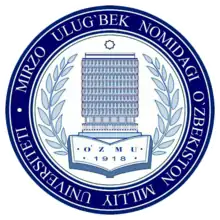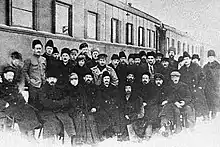National University of Uzbekistan
National University of Uzbekistan (NUUz) (Uzbek: Mirzo Ulugbek nomidagi O'zbekiston Milliy Universiteti, O'zMU) is a public university located in Tashkent, Uzbekistan. NUUz is the oldest and largest university in Uzbekistan.
Mirzo Ulug'bek nomidagi Oʻzbekiston Milliy Universiteti | |
| Type | Public |
|---|---|
| Established | 1918 |
| Rector | Marakhimov Avazjon Rakhimovich |
Academic staff | 14 |
Administrative staff | 1,200 |
| Students | over 10,000 |
| Location | , |
| Campus | Urban |
| Website | www.nuu.uz |


National University of Uzbekistan is named after Mirzo Ulugbek. NUUz professors and teaching staff work with modern materials and science and have relationships with the world's distinguished scientific schools.
History

Higher educational institutions originated in eastern Iran in the 10th century CE and spread to major urban centers throughout the Middle East by the late 11th century.[1] Simultaneously, universities were established in the West.
In the beginning of the 20th century, jadids tried to establish universities with the collaboration of Russian democrats. Muslim People University was headed by a council consisting of 45 people. It aimed to offer higher, secondary and primary education. In autumn, Muslim People University and its founders were the first victims of repression from communists.
The government of the Soviet Union, headed by Lenin, founded Turkestan People's University in 1918 with 1,200 students. It was renamed to Turkestan State University in 1920, then renamed to First Central Asian State University in 1923 and renamed again to Tashkent State University, named after Lenin in 1961 and finally named National University of Uzbekistan after Uzbekistan's independence.[2]
In 1961-1969, NUUz won the first place among institutions in Central Asia in the contemporary system of education and became one of the most prestigious higher institutions of the Soviet Union. Many Central Asian national universities were established on the basis of the NUUz, including Abai Kazakh National Pedagogical University (1925), High Pedagogy Institute of Tajikistan (1932) and the Institute of Agriculture of Tajikistan (1931).
During World War II, many academics relocated from cities in the western USSR to Central Asia, Tashkent and Alma-Ata, which were favored for their European-style infrastructure and the presence of a significant number of Russian speakers.[3]
In the spring of 2008, the President of the Republic of Uzbekistan, Islam Karimov, signed the resolution of the 90th anniversary from the date of foundation of the university in September 1918.
In September 2018, two joint faculties with Kazan Federal University and Holonsky Israeli Technical Institute began to function.
Organization
The 14 faculties and 74 departments include:
- Mathematics
- Physics[4]
- Geology and geoinformation systems[5]
- Geography and natural resources
- Chemistry
- Biology
- Social sciences
- History
- Economics
- Foreign Philology
- Journalism
- Taekwondo and sport studies[6]
- Uzbek-Israel joint faculty of Mathematical engineering and computer science
An academic lyceum named after S. H. Sirojiddinov operates under NUU. It was founded in 1970 as a boarding school of young physicists and mathematicians. Over 100 PhD professors and over 200 PhD associate professors are among the lyceum's graduates.
Campuses and museums
There are 9 hostels on the “Yoshlik” campus, in which over 3200 undergraduate and graduate students live. Internet service, computer classes, international and trunk calls, a student's clinic, a sports and recreation facility, dry cleaning, dressmakers and shoemakers, training and cultural centers, libraries, dining halls, a market and shops are at the disposal of the students. Rooms for spirituality and enlightenment and also living rooms in each hostel for teachers who continue the training process with the students after classes.
Museums
NUUz has 5 museums.
History of the University Museum
This museum is designed to demonstrate the contribution of NUUz in the spread of scientific knowledge throughout Central Asia.
Rare Manuscripts Museum
Founded on March 31, 2006, this museum contains manuscripts dated to the 16th-20th centuries in the Uzbek, Tajik, Persian, Turkish and Arabic languages. These manuscripts have been kept in the University's Information and Resource Centre for 80 years. This collection began to be compiled in 1920. One of the most valuable literary pieces is Zafarnoma by Sharafiddin Ali Yazdi, created in 1454 and illustrated 12 years after its creation by a calligrapher Kamoliddin Bekhzod. Another copy of Zafarnoma is in the library of Paris University. It also holds a copy of the Quran made during the reign of the Moguls in the 16th century. In addition, works of A.N Avoi (Khamsa), Z.M.Babur's (Baburnoma, The Deeds of Tamerlane, Iskandarnoma) and other similar precious manuscripts are archived.
Archaeology and Ethnology Museum
Incorporating archaeological finds collected in Uzbekistan and Turkmenistan. Educational archaeological expeditions of the members of the sub-department “The Archaeology of Central Asia” have filled the museum expositions.
Zoology Museum
The zoology collection exhibits the largest scientific compilation in the country, gathered and maintained for over 100 years, encompassing 23,500 specimens. It includes 560 species of birds, a collection of vertebrates, rare and endangered species, as well as the exhibits of 129 kinds of unique and unprotected mammals.
Geology Museum
1400 exhibits of petrified plants and animals from the paleolithic age are displayed.
Degrees
The Bachelor's degree (4 years) has 46 programs.
The Master's degree (2 years after Bachelor's) has 76 programs.
The PhD (3 years after Master's) has 68 programs.
A D.Sc. (2–3 years after PhD) is offered.
Notable alumni
- Elyor Karimov
- Rashid Kadyrov
- Maimul Ahsan Khan[7]
- Jahangir Mamatov
- Vladimir Vapnik, developer of support vector machines
- Abdulla Aripov, awarded the title Hero of Uzbekistan
- Zamira Ismailovna Usmanova, archaeologist and first woman graduated at the National University of Uzbekistan
- Ruslan Medzhitov
- Erkin Vakhidov
- Ozod Sharafuddinov
- Sadi Sirajitdinov
- Tashmukhammad Sarimsakov
- Obid Sadikov
- Sadik Azimov
- Ubay Oripov
- Habib Abdullaev
- Gulam Karimov
- Ibrakhim Muminov
- Prof.Eduard Yakubov[8]
See also
- Inha University in Tashkent
- Tashkent State Technical University
- Tashkent Institute of Irrigation and Melioration
- Tashkent Financial Institute
- Tashkent Automobile and Road Construction Institute
- Management Development Institute of Singapore in Tashkent
- Tashkent State University of Economics
- Tashkent State Agrarian University
- Tashkent State Institute of Oriental Studies
- Tashkent State University of Law
- Tashkent University of Information Technologies
- University of World Economy and Diplomacy
- Westminster International University in Tashkent
References
- "Madrasa". Encyclopedia.com.
- "General information". Archived from the original on 2019-07-16. Retrieved 2009-06-19.
- Paul Stronski, Tashkent: Forging a Soviet City, 1930-1966 (University of Pittsburgh Press, 2010: ISBN 0-8229-6113-X), pp. 94-95.
- "faculties". Archived from the original on 2019-07-16. Retrieved 2009-06-19.
- "faculties".
- "faculties".
- "Maimul Ahsan Khan". IIE Scholar Rescue Fund.
- "Prof. Eduard Yakubov, Board - President of HIT in HIT".